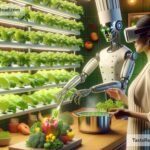The Future of Food and Collaborative Global Systems: Building a Healthier Planet Together
Food is at the heart of human life. It brings families and communities together and fuels our bodies to work, think, and grow. But as the world changes, so does the way we grow and share food. Climate change, population growth, and limited resources are making it harder to produce enough food in traditional ways. At the same time, millions of people go hungry while others face health issues caused by unhealthy diets. To solve these big challenges, the future of food must be built on innovation and cooperation between nations, industries, and individuals. Here’s how we can imagine a brighter and more sustainable food system through global teamwork.
Challenges in Food Production Today
Before diving into the future, it’s important to understand the problems we’re facing. On one hand, the world’s population is growing rapidly. Experts predict that by 2050, there will be close to 10 billion people on Earth. Feeding this many people with the same farming methods we use today would require more land, water, and energy—resources that are already stretched thin.
On the other hand, climate change is making farming unpredictable. Rising temperatures, changing weather patterns, and natural disasters are affecting crops and livestock around the world. This means farmers may face reduced harvests at a time when we need even more food.
There’s also a significant problem with how food is distributed globally. While some countries produce large amounts of food, others struggle to feed their populations. According to the United Nations, nearly 828 million people suffer from hunger, even though we produce enough food globally to feed everyone. This is a clear sign that our food systems need to become fairer and more efficient.
What Does the Future of Food Look Like?
The future of food will not just involve growing crops and raising animals—it will include breakthroughs in technology, science, and international cooperation. Here are some key trends and innovations shaping the food systems of tomorrow:
-
Alternative Proteins: Meat and dairy production are resource-heavy processes with significant impacts on the environment. As a solution, scientists and innovators are creating alternative protein sources like plant-based meats, lab-grown meat, and insect protein. These foods use fewer resources and create less pollution while still providing the nutrition people need.
-
Smart Farming: Technology is transforming agriculture through innovations like precision farming, drones, and AI tools. These allow farmers to monitor soil health, water levels, and plant growth in real time, helping them produce more food with fewer resources. Urban farming techniques, like vertical farms and hydroponics, make it possible to grow food in cities, reducing the distance food travels to reach consumers.
-
Personalized Nutrition: Advances in science are making it easier to understand individual nutritional needs. In the future, people might use DNA-based diets or wearable devices to track which nutrients their bodies require. This technology can help prevent diseases caused by poor diets, like diabetes and heart problems.
-
Reducing Food Waste: Did you know that one-third of all food produced globally goes to waste? High-tech solutions like AI-driven supply chains and better storage options can help reduce this waste. Collaborative efforts can also encourage grocery stores, restaurants, and consumers to share excess food with those in need.
-
Climate-Resilient Crops: Scientists are developing crops that can withstand harsh weather conditions, droughts, and pests. These genetically modified or selectively bred crops can help ensure food security in areas affected by climate change.
Why Collaboration Is Key
The food challenges of tomorrow cannot be solved by any single country or organization. They require collaboration on a global scale. Countries must work together, sharing knowledge, technology, and resources to create a sustainable food system. International groups like the United Nations and the World Bank already play a role, but their efforts must grow even more to match the rising demand for food solutions.
For example, wealthier nations can help fund projects to improve farming techniques in developing countries. At the same time, scientists and universities can share research to ensure farmers everywhere have access to tools and knowledge. Companies that produce innovative food products, like alternative proteins, can work to make their products affordable and accessible for all people, not just those in wealthy countries.
We can also learn from one another culturally. Traditional farming techniques and local crops in certain regions may hold answers to future food challenges. In many cases, indigenous communities have long practiced sustainable farming methods that blend well with modern technology.
What Can Individuals Do?
Collaboration isn’t just about big organizations—individuals also play an important role. By making thoughtful food choices, people can help shape the future. For instance, eating less meat and choosing plant-based foods can reduce environmental harm. Supporting local farmers and buying seasonal produce can help build stronger, localized food systems. And reducing food waste at home—whether by planning meals carefully or composting scraps—can make a significant impact.
Education also matters. Learning about food systems and discussing these issues with friends and family can inspire others to take action. When more people understand the importance of sustainable food systems, they can demand change from companies and policymakers.
A Shared Path to a Better Future
The future of food is deeply tied to the health of our planet and the well-being of its people. By working together across borders and industries, we can innovate solutions, reduce hunger, and protect the environment for future generations. Whether it’s producing climate-resilient crops or building fair food distribution networks, collaboration is the key to success.
As consumers, farmers, scientists, and leaders, we all have a role to play. The choices we make today can create a food system that is healthier, fairer, and more sustainable. Together, we can shape a future where everyone has access to nutritious food—and where the planet thrives alongside us. After all, food is not just about survival; it’s about connection and care for one another. Let’s make that connection stronger, starting now.

